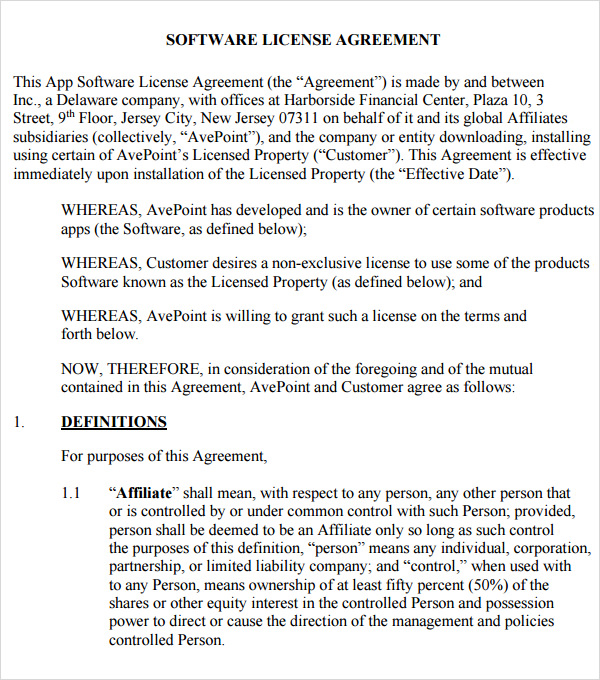A software license agreement is a legal contract between a software developer or vendor and the end-user of the software. It outlines the terms and conditions under which the software can be used, distributed, and accessed. This agreement ensures that both parties understand their rights and responsibilities regarding the use of the software.
Software license agreements are essential in protecting the intellectual property rights of software developers and providing users with the necessary permissions to use the software legally. These agreements may vary in their terms depending on the type of software, its intended use, and the specific needs of the parties involved.
Why Do You Need a Software License Agreement?
Software license agreements serve several important purposes:
1. Protection of Intellectual Property: A software license agreement helps safeguard the rights of software developers by outlining the permitted uses and restrictions on the software’s distribution and modification.
2. Clarification of Usage Rights: The agreement clearly defines how the software can be used, whether it is for personal or commercial purposes, and any limitations or restrictions on usage.
3. Liability Limitation: The agreement may include provisions that limit the software developer’s liability in case of any damages or issues arising from the use of the software.
4. Compliance with Laws and Regulations: Software license agreements ensure that both parties comply with applicable laws, regulations, and industry standards.
5. Dispute Resolution: The agreement may include provisions for resolving disputes, such as through mediation or arbitration, instead of resorting to lengthy and costly litigation.




Types of Software License Agreements
There are various types of software license agreements, each tailored to different software distribution models and usage scenarios. Some common types include:
1. End-User License Agreement (EULA)
An End-User License Agreement (EULA) is the most common type of software license agreement. It is typically used for commercially available software and outlines the terms and conditions for end-users who purchase or download the software.
The EULA specifies the rights and restrictions on using the software, any limitations on transferring or copying the software, and any disclaimers or warranties provided by the software developer.
2. Open Source License Agreement
Open-source license agreements are used for open-source software, which is released under licenses that allow users to freely use, modify, and distribute the software’s source code.
These agreements, such as the GNU General Public License (GPL) or the Apache License, outline the rights and responsibilities of users and developers when using open-source software.
3. SaaS Agreement
A Software-as-a-Service (SaaS) agreement is used for cloud-based software services. It defines the terms and conditions for accessing and using the software over the internet.
The SaaS agreement typically includes provisions related to data privacy, service level agreements (SLAs), and payment terms for the subscription-based service.
4. Proprietary License Agreement
A proprietary license agreement is used for software that is not open source and is owned by a specific company or individual.
These agreements outline the terms and conditions for using the software, any restrictions on copying or distributing the software, and any warranties or support provided by the software owner.
Key Elements of a Software License Agreement
A software license agreement typically includes the following key elements:
1. Grant of License: This section defines the rights and permissions granted to the end-user, such as the right to use the software for a specific purpose or period.
2. Restrictions: The agreement outlines any limitations or restrictions on the use, copying, modification, or distribution of the software.
3. Ownership and Intellectual Property: This section clarifies the ownership of the software and any intellectual property rights associated with it.
4. Support and Maintenance: The agreement may include provisions for software updates, bug fixes, and technical support provided by the software developer.
5. Payment Terms: If applicable, the agreement specifies the payment terms, such as licensing fees or subscription costs.
6. Confidentiality: This section addresses the protection of confidential information shared between the parties during the software licensing process.
7. Termination: The agreement outlines the conditions under which the license can be terminated, such as breach of terms or non-payment.
8. Dispute Resolution: This section specifies the method for resolving disputes, such as through mediation, arbitration, or litigation.
How to Create a Software License Agreement
Creating a software license agreement involves several important steps:
1. Define the Scope and Purpose
Clearly define the scope of the software license agreement, including the specific software being licensed, its intended use, and any limitations or restrictions.
2. Identify the Parties
Identify the parties involved in the agreement, including the software developer or vendor and the end-user or licensee.
3. Outline the License Terms
Specify the rights and permissions granted to the end-user, any restrictions on usage, and the duration or term of the license.
4. Include Intellectual Property Clauses
Include clauses that address ownership of the software and any intellectual property rights associated with it.
5. Address Support and Maintenance
Specify the level of support and maintenance provided by the software developer, including any updates or bug fixes.
6. Define Payment Terms
If applicable, outline any licensing fees, subscription costs, or payment terms agreed upon by both parties.
7. Incorporate Confidentiality and Non-Disclosure
Include provisions that protect the confidentiality of any proprietary or sensitive information shared during the licensing process.
8. Include Termination and Dispute Resolution Clauses
Specify the conditions under which the license can be terminated and outline the process for resolving any disputes that may arise.
Conclusion
A software license agreement is a crucial document that protects the interests of both software developers and end-users. By clearly defining the terms and conditions of software usage, these agreements ensure compliance with laws, protect intellectual property rights, and provide a framework for resolving disputes. It is important for both parties to carefully review and negotiate the terms of the agreement to ensure a fair and mutually beneficial relationship.
Software License Agreement Template – Download
